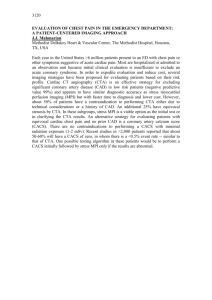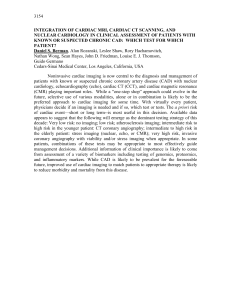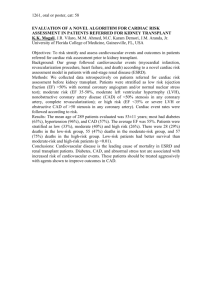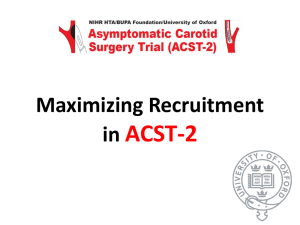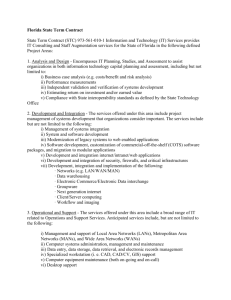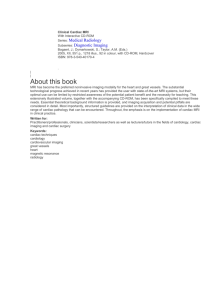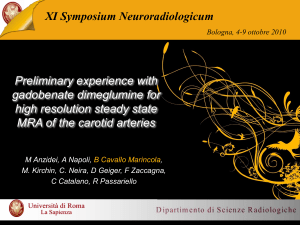Cardiac CT & Cardiac MRI
advertisement
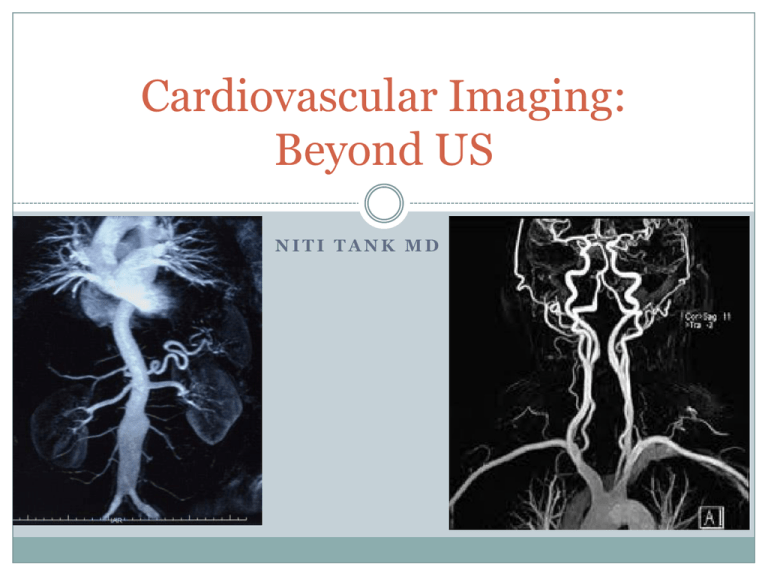
Cardiovascular Imaging: Beyond US NITI TANK MD Objectives To understand common capabilities shared by CT and MRI To understand strengths and limitations of CT and MRI To learn the decision process from choosing CT versus MRI for cardiovascular imaging Cardiac imaging Indications for Cardiac CT Diagnosis of coronary artery disease (CAD) in a patient with symptom(s) that may represent anginal equivalent: Low or intermediate probability of stenotic CAD or stenotic bypass graft disease is sufficient. Stress testing is contraindicated, not tolerated, or likely to generate artifact (body habitus, uncontrolled severe hypertension, large aortic aneurysm, left bundle branch block, suspicion of left main or severe multi-artery disease) Stress testing result is equivocal or discrepant from clinical presentation Persistence of symptoms despite normal stress test result – in place of catheterization Evaluation of bypass graft anatomy – in place of catheterization Concurrent evaluation of aorta is desired Indications for Cardiac CTA Coronary artery anomaly: < 40 years-old and symptoms or prior imaging suggests possible coronary anomaly Evaluation of Fistula, AVM, aneurysm or pseudoaneurysm Planning interventional/surgical procedures Evaluation for stenotic CAD before valvular or aortic surgery – in place of catheterization Evaluation of bypass graft and chest wall anatomy before redo open heart surgery Left atrial / pulmonary vein evaluation before EP procedures to treat atrial fibrillation Evaluation of left ventricular outflow tract and aorta before TAVR Evaluation of cardiac mass and/or thrombus Cardiac CT Angiogram Optimal patient characteristics* Resting sinus heart rate < 80 beats per minute Able to safely take metoprolol and nitroglycerin Able to hold breath for 10 seconds Body mass index (BMI) < 40 kg/m2 No stent or coronary artery bypass surgery *Expect sensitivity > 95% and specificity > 80% for detecting stenotic CAD in patients meeting above criteria Strong Contraindications Severe contrast allergy (anaphylaxis, shock, coma, seizure) Creatinine clearance < 30 ml/min or acute renal failure More than 10 PVCs/min Cannot follow instructions or cannot hold breath for 10 seconds High suspicion for acute coronary syndrome or stenotic CAD Cardiac CT for Coronary artery disease ECG synchronization- time image acquisition to cardiac cycle Retrospective Prospective Contrast bolus types and timing depends on particular indication Various reformats Malignant right coronary artery Cardiac Calcium Scoring Addition of CACS to a prediction model based on traditional risk factors significantly improved the classification of risk Calcium Score Presence of CAD 0 No evidence of CAD 1-10 Minimal evidence of CAD 11-100 Mild evidence of CAD 101-400 Moderate evidence of CAD Over 400 Extensive evidence of CAD Who should be screened using CT for calcium scoring? - Patient with risk factors for CAD (high cholesterol, DM, HTN, Smoker, obese, FH of CAD) What are the limitations of Cardiac CT for Calcium Scoring? - weight limit, CAD can still be present without calcium even if your calcium score is low, HR > 90, insurance coverage Cardiovascular MRI - indications Cardiac Global and regional left and right ventricular function, and volume Cardiac and extracardiac masses Cardiomyopathies Myocarditis Valvular function (qualitative/quantitative) Pericardial disease Congenital heart disease Myocardial viability Poor quality echocardiograms Cardiac MRI technique Morphology Wall motion Valve movement Breath hold and ECG Function Blood volume Flow Cardiac output Tissue property Perfusion Delay enhancement Tumor/mass gated Bright blood/dark blood sequence Cine Phase encoding Perfusion and delay postcontrast imaging Infarct is bright on lateenhancement images. When a coronary artery is occluded subendocardially progresses towards the epicardium depending on the duration of the occlusion Subendocardial infarct vs. transmural infarct. Myocarditis: Delayed enhanced imaging demonstrate enhancement in the mid-myocardium often in a patchy pattern Nonvascular distribution Myocarditis an abnormal protrusion of the interatrial septum ranging from >11mm to >15mm beyond normal excursion in adults can be limited to the fossa ovalis or entire interatrial septum Interatrial septal aneurysm Contraindications – Cardiac MRI Severe claustrophobia Foreign body near vital structures Metallic implants – Neurostimulators, Cochlear implants, Bone growth stimulators, pacemakers/ICD Intracranial aneurysm clips Vascular clamp Insulin or infusion pump or implanted drug infusion device Acute renal failure/ chronic renal dysfunction Nephrotoxic Systemic Fibrosis (NSF) occurs exclusively in patients with reduced renal function, including dialysis patients with gado use Painful skin induration in extremities with contracture Risk Factors: Any patient with eGFR <30 ml/min/1.73m2 Acute renal failure eGFR < 60 AND proinflammatory conditions/event unenhanced MR may be a better approach for avoiding the potentially severe adverse effects associated with contrast materials. Imaging of Aorta Aneurysm Incidence of AAA – 4% of ppl > 50 yrs of age Thoracic Aortic aneurysm: increase incidence with age, 7.5 per 100000, male predomiance Dissection Congenital – Coartation, Vasculitis – GCA, Takayasu Arteritis CTA of aorta Great for evaluation of acute aortic disorder (dissection, aneurysm rupture) and endovascular rx planning/stent followup short scan time and easy to perform Large FOV Better spatial resolution (vs. MRA) Disadvantages Long post-processing time Radiation Beam Harding from metallic artifact MRA of aorta Better for congenital abnormalities, serial follow up of Aneurysm, vasculitis, younger patient population Endovascular rx planning in ascending aortic aneurysm with visualization of aortic valve on cine imaging Large FOV Shorter post processing time No artifact related to calcifications Greater soft tissue contrast Disadvantage Technically complex Longer scan time - Claustrophobia/motion artifact Breath holding: chest/abd Metallic artifact from stents Coarctation of Aorta Peripheral Vascular Disease Occurs in approximately 1/3 of patients Over age 70 Over age 50 who smoke or have DM Strong association with CAD Obvious associated risk of stroke, MI, cardiovascular death Progressive disease in 25% with progressive intermittent claudication/limb threatening ischemia Outcomes Impaired QoL Limb Loss Premature Mortality Diagnosis modalities Ankle Brachial Index (ABI) Noninvasive vascular laboratory Ultrasound Angiography: MRA, CT, DSA Location based on symptoms Buttock/hip Usually indicates aortoiliac occlusive disease (Leriche's syndrome) Some cases, thigh claudication too Question diagnosis of bilateral disease if erectile dysfunction is not present Thigh Occlusion of the common femoral artery leads to claudication in the thigh, calf, or both. Calf Symptoms in upper 2/3 is usually due to SFA Lower 1/3 is due to popliteal disease. Ankle Brachial Index Cornerstone of lower extremity vascular evaluation Blood pressure cuffs, Doppler Ankle (DP or PT) to brachial artery pressure Limitations Noncompressible vessels Diabetes Renal Failure ABI >1.5 Use toe-brachial index Normal >0.7 Rest pain <0.2 Subclavian/Brachiocephalic Occlusive disease Duplex Doppler Non-invasive method of evaluating the blood vessels. Can obtain both anatomic and hemodynamic information. Anatomical detail vessel wall intraluminal obstructive lesions perivascular compressive structures Doppler Waveform Analysis: Hemodynamic Information Sensitivity of 92.6% and specificity of 97% (angiography gold standard) Inaccurate at adductor canal and the aorto-iliac regions. 95% accuracy in the detection of bypass graft stenosis, but can overestimate stenosis Polack JF. Duplex Doppler in peripheral arterial disease. Radiol Clin N Amer 1995; 33 : 71-88. PAD Advances in noninvasive imaging methods: computed tomography (CT) magnetic resonance (MR) imaging replaced invasive angiographic procedures lowering the cost and morbidity of diagnosis CTA – current technique Multidetector CT scanner necessary (4+)- most are now 64 Slice Iodinated contrast volume similar to conventional angiography 80-150 cc Automated Scan Delay Renal arteries to ankles 10-minute exam Post processing software crucial CT angiogram Advantages Faster study Intervention planning Excellent renal to ankle imaging – high spatial resolution Images soft tissue and bone as well CT limitations Radiation Pregnancy Blooming artifact from calcification • overestimate stenosis Need contrast: renal function contrast allergy Uncooperative patient Bad Pump Inconsistent pedal vessel visualization Longer postprocessing time MRA current technique 2D or 3D Time of Flight Unsaturated blood produces bright signal and background tissue is saturated Contrasted Enhanced 20-40 cc gadolinium injection Automated Scan delay 45-min exam Pooled sensitivity 97%, specificity 96% Higher temporal resolution MR angiogram - Advantage Localizing disease extent and severity Providence guidance for intervention No radiation Can do with and without contrast (better for patient with renal issue or contrast allergies) Better for foot and ankle vascular imaging (esp in calcified vessels) Evaluate inflow grafts: (aorto–biiliac, aortobifemoral, axillobifemoral) MRA vs. DSA Limitations of MRI Longer scan time Pre-screening is required- Pacemakers/ICDs, metallic implants More costly Metal artifacts can be mistaken for stenosis Unable to characterize vascular calcification Uncooperative patient/ Claustrophobia Carotid arterial disease Carotid disease and Stroke Up to 83% of all stroke, TIA or amaurosis fugax – maybe from carotid bifurcation atheromatous disease CEA produces an absolute reduction of 17% in stroke at 2 years when compared to ASA in symptomatic patients with 70% or greater ICA stenosis. Risk of no treatment is 26%. Risk of CEA is 9%. Carotid Ultrasound Most accurate, noninvasive cost-effective method for diagnosis of extracranial cerebrovascular disease Intimal thickening and plaque morphology Doppler velocity spectral analysis High negative predictive value Vertebral artery evaluation (assess for subclavian steal) CTA of Carotid artery Accurate quantitation and anatomic localization Luminal and non-luminal information Tandem stenosis Longitudinal follow-up 3D visualization Extended coverage pooled sensitivity of 95% and a specificity of 98% for the detection of >70% stenosis Greater for assessment of dissection Limitations of CTA Contrast allergy Renal dysfunction Radiation Gross patient motion artifacts Artifacts Beam hardening artifacts: amalgam, hyper-concentrated contrast Reconstruction artifacts Contrast gradient artifacts Stent blooming artifacts Simultaneous arterial and venous imaging Low ejection fraction (heart failure) Overestimation of stenosis in thick calcific plaque MRA - Technique TOF: Noncontract imaging which captures blood flow information 2d TOF – rapid acquisition but susceptible to motion artifact 3d TOF – high spatial resolution (sensitive to medium to high flow) but insensitive to low flow. Contrast enhanced MRA May be performed in 2d imagine along any plane as well as 3d Usually performed in coronal plane with reformats Fast imaging approximately 10 minutes TOF vs.CEM MRA – CEM vs. TOF Advantages Shorter scan time – less artifact from motion Large coverage More accurate stenosis and occlusion Contrast independent of flow direction Less contamination from short T1 materials Better SNR vs. TOF-MRA Less signal loss from slow/turbulent flow Great for evaluation of dissection MRA – CEM vs. TOF Disadvantages Longer prep time – more venous signal Lower spatial resolution (vs. TOF-MRA and CTA) Stents and metallic artifact T2* effects with bolus Maki effect (k-space ordering) Vessel diameter varies during contrast bolus cycle No calcifications Advantage of CTA over MRA Provides information about vessel lumen and vessel wall in single study vs. contrast enhanced MRA (CEMRA) and TOF-MRA No vascular signal artifacts arising from slow/complex/turbulent/in-plane flow vs. TOF MRA Higher spatial resolution Widely available Easier to acquire Lower cost Disadvantage of CTA over MRA Radiation Contrast allergy (1:30,000) Longer processing time Renal insufficiency Simultaneous venous contamination Limited direct hemodynamic information. Gross motion and beam hardening. Upper extremity vascular disease broad spectrum of diseases ranging from acute limb- threatening ischemia to chronic disabling disease. less common than lower extremity vascular disease affects as much as 10% of the population CTA Upper extremity evaluate for stenosis, occlusion, aneurysm, or embolic events, especially when they affect vessels proximal to the wrist. vasculitis of large and medium arteries: Takayasu arteritis (TA), giant cell arteritis (GCA), and thromboangiitis obliterans Limitation - imaging of small vessels of the hand due to inconsistent enhancement of these vessels. Giant cell arteritis Subclavian Steal Thromboangiitis obliterans MRA upper extremity Great for Large and medium vessels Great for small vessels below the wrist Evaluation of stenosis, occlusion, trauma, vasculitides No radiation, can be done without contrast Longer study Usual contraindications. MRA hand When in doubt…call us!

